Background
Eugène lonesco was born on November 26, 1912, in Slatina, Romania, to a French mother and a Romanian father. The following year the family moved to Paris, but soon after he was 12, they returned to Romania.

1913
Eugène Ionesco as a child, Paris c.1913
1916
Eugene Ionesco with his mother Marie-Therese Ipcar, c. 1916.
Eugène Ionesco
Eugène Ionesco
Eugène Ionesco
Eugène Ionesco
Eugène Ionesco
Eugène Ionesco
Eugène Ionesco
Eugène Ionesco
Eugène Ionesco
Eugène Ionesco
Eugène Ionesco
Eugène Ionesco
Eugène Ionesco
Eugène Ionesco
Eugène Ionesco
Eugène Ionesco
Eugène Ionesco
Eugène Ionesco
Eugène Ionesco
Eugène Ionesco
Eugène Ionesco
Eugène Ionesco
Eugène Ionesco
Eugène Ionesco
Eugène Ionesco
Eugène Ionesco
Eugène Ionesco
Eugène Ionesco



































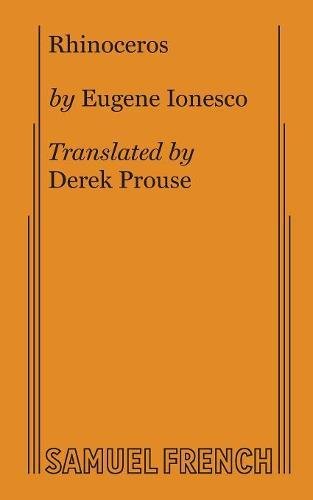
(The sublime is confused with the ridiculous in this savag...)
The sublime is confused with the ridiculous in this savage commentary on the human condition, a staple of every theatre classroom and 20th-century drama. A small town is besieged by one roaring citizen who becomes a rhinoceros and proceeds to trample on the social order. As more citizens are transformed into rhinoceroses, the trampling becomes overwhelming, and more and more citizens become rhinoceroses. One sane man, Berenger, remains, unable to change his form and identity.
http://www.amazon.com/gp/product/0573614741/?tag=2022091-20
1959
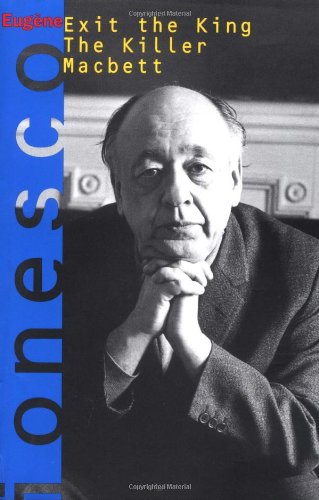
(Exit the King is a highly stylized, ritualized death rite...)
Exit the King is a highly stylized, ritualized death rite unfolding the final hours of the once-great King Berenger the First. As he dies, his kingdom also dies. His armies suffer defeat, the young emigrate, the seasons change overnight, and his kingdom's borders shrink to the outline of his throne. At last, as the curtain falls, the king himself dissolves into a gray mist.
http://www.amazon.com/gp/product/0802151108/?tag=2022091-20
1962
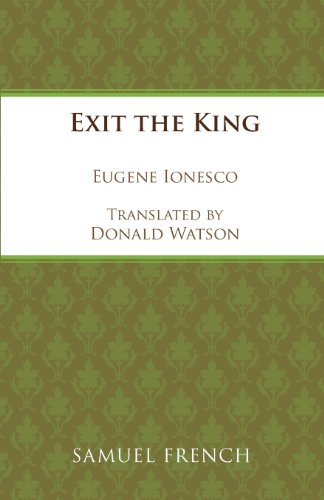
(First produced in 1963 starring Alec Guinness and success...)
First produced in 1963 starring Alec Guinness and successfully revived to great acclaim on Broadway in 2009, this absurdist exploration of ego and mortality is set in the crumbling throne-room of the palace in an unnamed country where King Berenger the First has only the duration of the play to live. Once, it seemed he ruled over an immense empire and commanded great armies, now his kingdom has shrunk to the confines of his garden wall. Refusing to accept his end, he is attended by his present and former Queens who must help him face the final inevitable truth of life: death.
http://www.amazon.com/gp/product/0573011230/?tag=2022091-20
1973
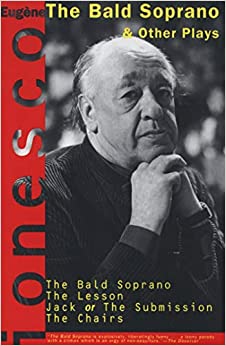
(The leading figure of absurdist theater and one of the gr...)
The leading figure of absurdist theater and one of the great innovators of the modern stage, Eugène Ionesco (1909-94) did not write his first play, The Bald Soprano, until 1950. He went on to become an internationally renowned master of modern drama, famous for the comic proportions and bizarre effects that allow his work to be simultaneously hilarious, tragic, and profound.
https://www.amazon.com/Bald-Soprano-Other-Plays-Submission/dp/0802130798/ref=tmm_pap_swatch_0?_encoding=UTF8&qid=&sr=
1982
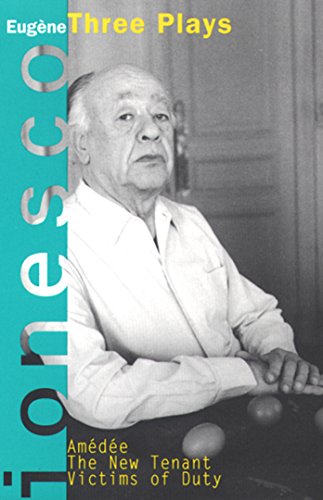
(This crucial collection combines The New Tenant with Améd...)
This crucial collection combines The New Tenant with Amédée and Victims of Duty - the plays Richard Gilman has called, along with The Killer, Ionesco's greatest plays, works of the same solidity, fulness, and permanence as those of his predecessors in the dramatic revolution that began with Ibsen and is still going on.
http://www.amazon.com/gp/product/B00VKI3UN0/?tag=2022091-20
Eugène lonesco was born on November 26, 1912, in Slatina, Romania, to a French mother and a Romanian father. The following year the family moved to Paris, but soon after he was 12, they returned to Romania.
Eugène Ionesco completed all of his secondary education in Romania and specialized in French at the University of Bucharest. From 1936 to 1938 Ionesco taught French in a secondary school in Bucharest.
In 1938 Eugène Ionesco received a grant from the French government to study in France and write a thesis on Sin and Death in French Poetry Since Baudelaire. During the war, he worked as a proofreader for a Paris publishing house.
Ionesco became a playwright in a roundabout way. While learning English, he was struck by the emptiness of the clichéd language that kept appearing in his phrasebook and decided to write a play using nonsensical sentences. The Bald Soprano (1948) was a comic parody of a play, an "antiplay" as he called it, portraying human life as automatism and language as a senseless fragmentation of sentences. Mr. and Mrs. Smith uttered cliches, while the couple visiting them, the Martins, spoke to each other as though they were strangers until they realized that they shared the same home and child. The dialogue amongst the four eventually disintegrates into meaningless sounds. The idea was that a new vision of reality might occur to audiences if habitual patterns of rational thought were overthrown and presented, not just with arguments about the irrationality (or absurdity) of human existence, but with demonstrations of it. The language theme continued in Ionesco's second play, The Lesson (1951), with a professor tutoring a female student in subjects ranging from the logical constructs of mathematics to the less rigorous rules of language. As the language tutoring progresses, the professor became increasingly agitated, and in the end stabbed his student during a discussion of the word "knife." Critics, never at a loss for words, found that the circular structure of these two plays suggested Ionesco's pessimism.
In later plays, Ionesco used multiplying objects as his metaphor for the absurdity of life. In The Chairs (1952), an elderly couple served as hosts for an audience which would assemble to hear a speaker deliver a message that will save the world. The couple arranged seating for their never-to-arrive guests, and the stage became crowded with chairs. Convinced that their audience had arrived and was seated, the hosts killed themselves, leaving them to hear the speaker who turned out to be a mentally-impaired deaf-mute. In The Victims of Duty (1953), coffee cups multiplied, and in The New Tenant (1957), the protagonist's apartment became progressively filled with furniture.
Later in the 1950's, Ionesco wrote several plays featuring a modern-day Everyman named Berenger (Ionesco's self-image). The most famous of these and the one that wrote his name large in English-speaking theater was Rhinoceros (1959). In this play, totalitarianism transformed everyone into a savage rhinoceros except Berenger, who thinks about joining them but in the end decided to fight them. The inspiration for the play was Ionesco's reaction to a friend having joined the Nazi party, but its significance was in its denunciation of mindless conformity to a mob mentality. In winning the Jerusalem Prize in 1973 for his entire oeuvre, Rhinoceros was singled out as "one of the great demonstrations against totalitarianism." Berenger also appeared in The Killer (1958), Exit the King (1962), and A Stroll in the Air (1963).
During the next 20 years, Ionesco's predominant theme was the subject of death, in such plays as Hunger and Thirst (1964), in which the protagonist (Berenger again) tried to escape death as represented by his wife and child; in The Killing Game (1970) an epidemic has taken away the inhabitants of a village. According to one critic, for Ionesco death represented the threat of nothingness, the "quintessence of the Absurd."
Many of Ionesco's plays had a dream-like quality. People can be transformed into animals or change their identity; they walked in the air or continued to grow after death. Ionesco preferred a series of states of consciousness over traditional plots. These dream-like qualities became more prominent in later plays, such as L'Homme aux Valises (1975) and Journey Among the Dead (1980).
In all, Ionesco wrote 28 plays, some of which have been in constant performance since 1955. He also wrote several volumes of essays, criticism and he created illustrations for some of his works as well. During the last 10 years of his life, he devoted himself to painting and exhibiting his works.
Eugene Ionesco and his wildly innovative plays, among them "Rhinoceros," "The Bald Soprano" and "The Chairs," overturned conventions of contemporary theater and had a profound effect on a new generation of playwrights. He has been called the founder of the Theater of the Absurd.
Elected to the Académie Française in 1970, Ionesco remains among the most important dramatists of the 20th century.
(This crucial collection combines The New Tenant with Améd...)
(First produced in 1963 starring Alec Guinness and success...)
1973(The leading figure of absurdist theater and one of the gr...)
1982(The sublime is confused with the ridiculous in this savag...)
1959(Exit the King is a highly stylized, ritualized death rite...)
1962The popular plays of the Franco-Romanian author Eugène Ionesco protested the dehumanizing effects of modern civilization and depicted the despair of the individual who vainly seeks meaning for his or her existence.
Ionesco’s achievement lies in having popularized a wide variety of nonrepresentational and surrealistic techniques and in having made them acceptable to audiences conditioned to a naturalistic convention in the theatre. His tragicomic farces dramatize the absurdity of bourgeois life, the meaninglessness of social conventions, and the futile and mechanical nature of modern civilization. His plays build on bizarrely illogical or fantastic situations using such devices as the humorous multiplication of objects on stage until they overwhelm the actors. The clichés and tedious maxims of polite conversation surface in improbable or inappropriate contexts to expose the deadening futility of most human communication. Ionesco’s later works show less concern with witty intellectual paradox and more with dreams, visions, and exploration of the subconscious.
Quotations:
"A work of art is above all an adventure of the mind."
"Ideologies separate us. Dreams and anguish bring us together."
"It is not the answer that enlightens, but the question."
"A man with a soul is not like every other man."
"A civil servant doesn't make jokes."
"I've always been suspicious of collective truths."
Ionesco was made a member of the Académie française in 1970.
Eugène Ionesco visited Israel and made declarations in favor of the state on the eve of the Six-Day War. After it was over he wrote about his family history for the first time in the second volume of his memoirs, Présent Passé, Passé Présent (1968), a sequel to Le Journal en Miettes (1957, Fragments of a Journal, 1968), expressing a new awareness of his Jewish origin.
In 1936 Eugène Ionesco married Rodica Burileano. They had a daughter, Marie-France Ionesco, for whom he wrote a number of unconventional children's stories.
